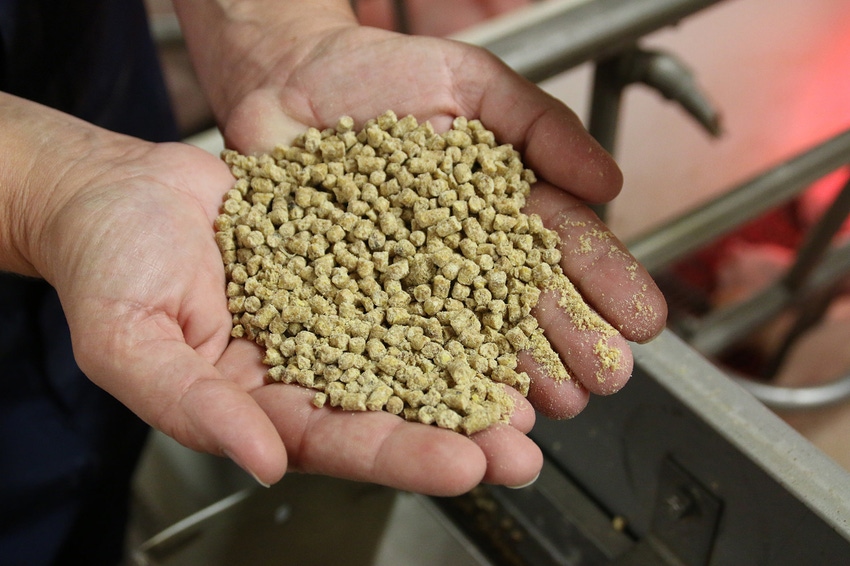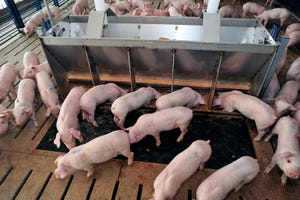Pelleting of diets for pigs improves feed efficiency
Even though pelleting is an extra process that increases feed cost, pelleting improves growth performance of pigs.
September 28, 2023

By Su A Lee and Hans H. Stein, University of Illinois, Urbana-Champaign
Diets for pigs are usually fed in a meal form or as pellets. Pelleting changes the physicochemical properties of feed ingredients and also impacts the handling properties of feeds. Even though pelleting is an extra process that increases feed cost, pelleting improves growth performance of pigs, which in turn may increase profits.
What is pelleting?
Pelleting is a mechanical process that uses heat, moisture and pressure to turn complete diets containing multiple feed ingredients into a compressed form. Therefore, the structures of nutrients in feed ingredients are changed by pelleting and thus nutritional values may also be changed.
Starch is the nutrient that is most affected by pelleting. Heat, moisture and pressure are applied to the feed ingredients during the pelleting process and starch in feed ingredients will become gelatinized during the process. Even though the gelatinized starch is retrograded after cooling, the starch granules are more accessible by glycoside hydrolases and thus the digestibility of starch is increased.
Protein molecules are naturally folded and applying heat during the pelleting process denatures the structure of protein by unfolding them. Therefore, this thermal denaturation of proteins may result in increase in digestibility of amino acids.
Feed handling properties are also improved by pelleting because pelleting reduces segregation of feed particles and thus provides a more homogenous feeds to pigs. Flowability and bulk density of pelleted diets are also increased.
Nutritional impact of pelleting diets for pigs
As starch is gelatinized by pelleting, starch digestibility is increased which also increases energy digestibility (Fig. 1 and Fig 2).
The digestibility of amino acids are usually also increased by pelleting because of thermal denaturation of proteins during the pelleting process (Fig. 3). Pelleting may also inactivate some anti-nutritional factors, which also may increase amino acid digestibility.
Because of the greater energy digestibility in pelleted diets, average daily feed intake of weanling and growing-finishing pigs is reduced if pigs are fed pelleted diets compared with diets in meal form (Table 1). However, daily gain tends to be increased in growing-finishing pigs fed pelleted diets and fed efficiency in both weanling and growing-finishing pigs is, therefore, improved by pelleting.
The quality of pellets is important to maximize the beneficial effects of pelleting. If the temperature used for pelleting is too high (> 85 °C), it is possible that the activity of supplemental enzymes may be reduced, which results in a reduction of growth performance of pigs. Pelleting also reduces particle size of grains, which likely contributes to the positive impact of pelleting on energy digestibility because a reduction in particle size results in increased energy digestibility.
Conclusion
Pelleting is one of the processing technologies that may be used to increase the nutritional value of diets for pigs. Pelleting increases the digestibility of nutrients and energy and also increases feed efficiency. Pelleting also improves feed handling properties and palatability of diets, which reduces the feed wastage and contributes to the increased feed efficiency.
References
Lancheros, J. P., C. D. Espinosa, and H. H. Stein. 2020. Effects of particle size reduction, pelleting, and extrusion on the nutritional value of ingredients and diets fed to pigs: A review. Anim. Feed Sci. Technol. 268:114603.
Lee, S. A., D. A. Rodriguez, and H. H. Stein. 2023. Interactive effects of pelleting and particle size reduction of corn on ileal digestibility of starch and amino acids in corn-soybean meal diets fed to pigs. J. Anim. Sci. 101(Supple.2). (Abstr.)
You May Also Like



